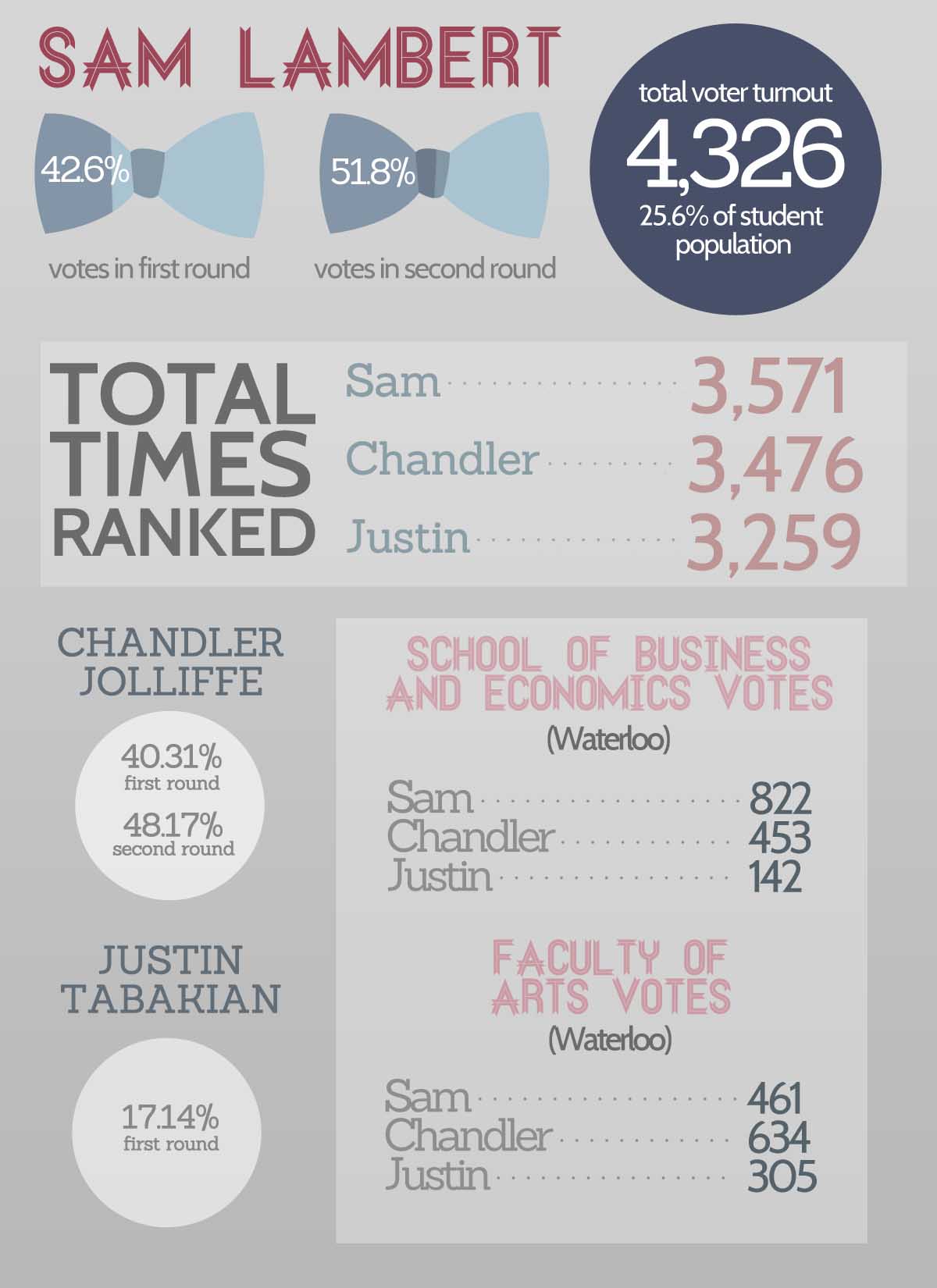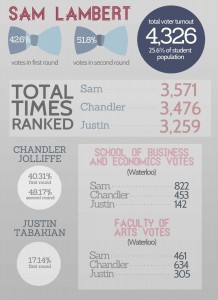New voting system put to the test


On Feb. 5 and 6, students at Wilfrid Laurier University used the new ranked voting system to make their voices heard in the Students’ Union elections. The new system was passed by referendum in the 2013 election, instituting a single transferrable voting system for the board of director and senate positions and an optional instant runoff voting system for the president and board of governor positions.
Jordan Epstein, chair and chief governance officer at the Students’ Union, discussed the impact the electoral reform had on the election results.
Sam Lambert won the election with 51.8 per cent of the votes. Epstein noted that, regardless of whether they used the system from last year or the new ranking system, Lambert would have won.
Lambert won the first round with 42.6 per cent of the votes. He also won based on how many times each candidate was ranked, with 3,571 over Jolliffe’s 3,476 and Justin Tabakian’s 3,259.
“He clearly had the most name recognition,” said Epstein. “Regardless of what they thought, they put him on the ballot.”
Additionally, analysis shows that the majority of first priority votes for Lambert by faculty and campus came from the school of business and economics (SBE) in Waterloo. He received 822 votes from students in that faculty. The closest number of votes that any of the other presidential candidates received from one faculty was Jolliffe with 634 votes from the faculty of arts.
Total voter turnout this year was 4,326 — or 25.6 per cent of Laurier’s student population. According to Epstein, the first year Laurier did online voting turnout was 33 or 34 per cent.
“That’s concerning on our end,” he said. “But that’s just an individual trend. Compared to other universities, we’re not concerned that our elections are not taken seriously on campus because – at the very least – we’re on par with the other schools.”
Dani Saad, chief returning officer at the Students’ Union, said that he wasn’t satisfied with turnout but that “you never are.”
“It was down from last year, but I think that’s reflective of the demographics in relation to the candidates that were there,” he continued. “Brantford was down big time because there were no candidates running for Brantford positions other than the acclaimed ones. There was also no female candidate for president and no minority candidate for president.”
As Saad noted, voter turnout in Brantford halved this year.
“For the Brantford vote to drop that drastically is a little worrying,” Epstein said. “Actually, based on the way the results look at the moment, they could have very well decided who was president.”
Brantford students overwhelmingly voted for Chandler Jolliffe over the other two candidates.
“There’s nothing to prove that the trend would have stuck, but if it did, the candidates were close enough together that if we had 600 people vote, just proportionally doubling those numbers, that very well might have been enough to swing the election.”
In terms of WLUSU’s board of directors, the trend was that students ranked only one candidate. Epstein said they were surprised to see this, as the new voting style allowed them to rank all 14 candidates.
“For me, with the board system, that sticks out that we need to be educating people in advance of elections what makes a good board candidate, what makes a good director, so that they feel comfortable with ranking people,” Epstein said.
The opposite trend emerged for student senators and president, however. With presidential votes, most students ranked all three candidates. As well, for senate, more students ranked all six candidates.
“It shows that, for a position where people can easily identify their opinion on who is better than who, they want to use the full ranking system,” said Epstein.
On Thursday night, results were delayed due to an issue with the vote counting for the board of director positions.
“We had a little coding error that we’d been trying to resolve for about a week, but never ended up getting finalized,” explained Epstein.
For each individual round, the vote counting system was functioning properly; however, votes were not being transferred between rounds.
By 12:30 a.m., they were down to two candidates for the last director position. Epstein said they realized they were not going to get to the final result anytime soon.
“We realized that then, so we just made it our priority to get the other results out and get the first 12 directors elected that night out,” he said.
“I do really feel for them for that they were there,” Epstein continued, referring to the final candidates Mohammad Malik and Shawn Okum. “Could not have been easy. But for the sake of every other candidate, we felt it was the right decision to make.”
Okum ended up being the 13th elected director.
“For next year, this should not be an issue.”
They are also looking at finding better ways to explain the voting system to students as well as looking at other ballot systems that would be more user-friendly.
“Overall I was happy with how the process went and I think the candidates had a good experience along with the voters,” said Saad.


